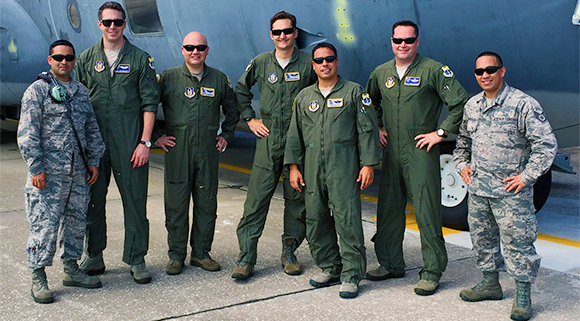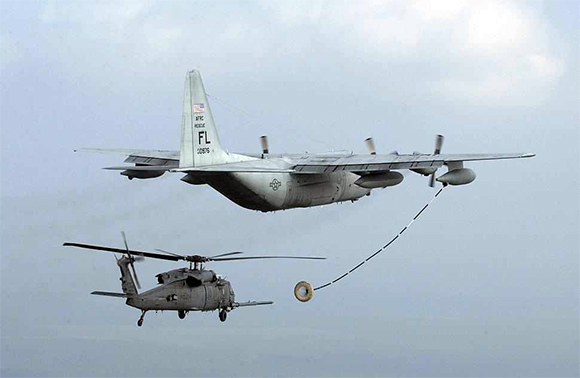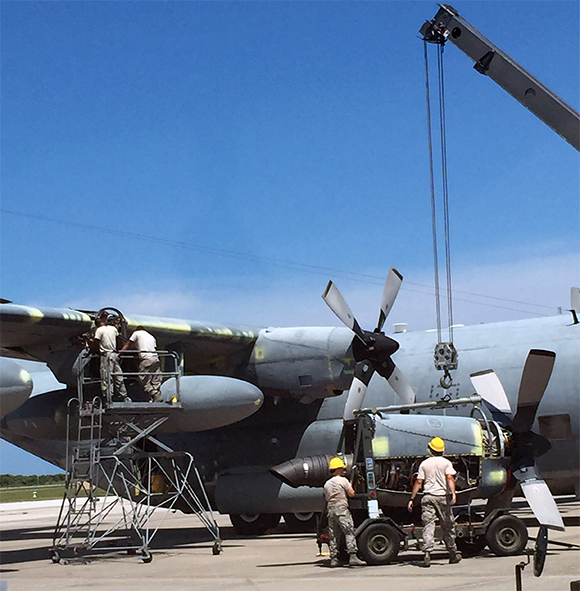Patrick Airmen Bid Farewell to Legacy Fleet of Rescue Champions
By Master Sgt. Elizabeth Moody, 920th Rescue Wing // January 11, 2016
HC-130P/N King aircraft retired

BREVARD COUNTY • PATRICK AIR FORCE BASE, FLORIDA – With no fanfare other than the fading rumble of its four turbo-prop engines, one of Patrick’s well-worn HC-130P/N King aircraft – number 65-00976 – disappeared into the afternoon sky heading into retirement at Davis-Monthan Air Force Base’s 309th Aerospace Maintenance and Regeneration Group, the aircraft retirement “bone yard,” in Arizona.
Throughout the fall of 2015, Rescue Wing Airmen piloted its grand fleet of six fixed-wing aircraft, familiar to many on Florida’s Space Coast, one-by-one, to their final resting place in the desert.
For nearly 50 years, this ubiquitous combat proven aircraft served the mighty Air Force, providing superior air support for its Airmen in many types of missions around the world.
However, one of the most unique aspects of its service to the nation has been supporting rescue operations – saving lives, from right here in Cocoa Beach.
There are no collected statistics on just how many lives have been saved by this airplane, but going back through its rescue life there are milestones which lend to the grandeur of its legacy.
A snapshot of America’s modern day history will only begin to scratch the gray-painted surface of all of those who owe their life to this hunk of metal built to save lives. The Airmen who maintained and flew it made it so, but two attributes differentiate it from others like it – its refueling capacity and its layout and design.

As a refueling aircraft, it gives the HH-60G Pave Hawk helicopter an unlimited range of rescue, and due to its design and layout with wide-viewing windows, it allows the whole crew to take part in search and rescues far below the clouds.
Its 920th story begins as a legacy of training to search for astronauts forced to bail out of spacecraft; being the first in prior to the Iraq War; flying overwatch above the frigid Icelandandic northern shipping lanes; hugging the mountaintops outside of Afghanistan; deploying to search for mariners lost at sea; exploring Canadian mountain ranges and dusty African outposts; and cutting through Alaskan blizzards, to name a few, all to scour the earth for those in need of its life-saving capacity, all at the hands of its capable aircrew.
Before any aircraft is airborne, it has to first get by a tough-as-nails aerospace maintenance specialists, like those from the dedicated team at the 920th Aircraft Maintenance Squadron here.
Responsible for ensuring the plane is in perfect working order before every mission, crew chiefs and maintenance teams need to have a basic knowledge of all the aircraft systems, including airframe, engines, gears, hydraulics, avionics and electrical systems.
They are also responsible for basic preflight and post-flight inspections, which can take up to 6 hours to complete.
Master Sgt. Michael Silnutzer, 920 AMXS crew chief here, from nearby Jupiter, Florida, is a reservist with 26 years of experience keeping aircraft mission-ready.
“During preflight, you give the plane a final look-over to make sure it’s serviced with fuel, hydraulic fluid and liquid oxygen before giving it final approval,” said Silnutzer.
Maintainers overcome many daily challenges to keep the 920th RQW’s aircraft operational and crew chiefs have to constantly check systems, remaining alert to potential maintenance issues and critical failures.
“Especially on the road,” said Silnutzer. “Once I was in an aircraft flying low level maneuvers waiting for our customers to get off the ground as the sun was setting. We were flying maybe 700-800 feet off the ground over farmer’s fields when I looked at the right external tank and I thought I saw condensation. I realized we never got up high enough in altitude to build that kind of condensation and thought we’re leaking fuel – fast!”
Silnutzer said the crew quickly assessed the failure and confirmed there was a serious fuel leak.
“The flight engineer took the forward looking infrared ball and zoomed in and we could see the fuel leak coming from the right nose cone,” said Silnutzer. “We had to get down fast!”
Silnutzer said after making an emergency landing and evacuating the aircraft, his crew quickly went to work to repair the aircraft.
“The O-ring in the nose cone of the tank split,” said Silnutzer. “We spent four hours on the ground working to get the airplane back into operation, but it was a good save.”
Why does an aerospace maintenance specialist have so much responsibility? Because it’s not just a plane you’re putting in the air; it’s also pilots, patients, fellow aircrew, and others who rely on these maintainers to keep their aircraft operational and safe every time they take to the skies.

Tech. Sgt. Norberto Nieves, 920 AMXS crew chief here, is a 14 year reservist who hails from Puerto Rico. Nieves recalled a time when nothing but long, dirty, sweaty work, and a little old fashioned ingenuity would fix an aircraft problem.
“We were doing a mission with pararescuemen at Pope Army Airfield, North Carolina, and I received a midnight call from a flight engineer who told me their HC-130P/N had a flat tire.”
Nieves said he went to work right away and located a spare tire for the aircraft, before facing yet another challenge.
“We get there and its pitch black out, past midnight and discover we cannot jack the airplane to change the tire because it was sinking in a soft dirt runway,” said Nieves.
With some resourceful help from the fire department, Nieves said they were able to lift the airplane through an adaptor they placed in the strut, replace the tire and get the airplane back in the air before dawn.
“We were completely covered in mud,” said Nieves of his tireless effort to get the aircraft off the ground. “I have had my share of tough breaks getting muddy and dirty with these airplanes.”
“If you don’t break on the road, we call that lucky,” said Staff Sgt. Jorge Caraballo, 920 AMXS crew chief here from St. Cloud, Florida. “At the end of the day it’s very satisfying to see all the work you’ve done when the wheels are up and the airplane is flying. I take a lot of pride in that,” said Caraballo, a four-year reservist.
These maintainers perform their complex jobs with a heartfelt sense of pride and duty, evident to many, including their commander.
“My aircraft maintainers continue to prove that they are truly the best of the best,” said Maj. Stephen Young, 920th AMXS commander here. “They work tirelessly ensuring no steps are missed and all blocks on the aircraft forms are signed.”
The 920th AMXS maintainers worked for weeks to prepare each aircraft for their final flights to the boneyard, however, tail number 076 did not leave without a fight.
“We marshalled 076 out to the taxiway and it rolled out to the runway but immediately returned and shut down,” said Caraballo. “We found out the number two engine generator shelled out.”
“It completely destroyed itself'” said Nieves.
“We spent about three hours replacing the generator,” said Caraballo before launching it again.
Reflecting on the airplane refusing to be put to pasture, Silnutzer laughed and said, “It didn’t want to leave home.”
Young said when an aircraft maintainer retires or moves on to a new assignment it’s like losing a family member. Similarly, these aircraft are part of that same family.

“It is sad when a member of the unit either retires or moves to another assignment…it is like losing a family member,” said Young. “That is how it is when losing an aircraft to the boneyard for retirement,” said the commander.
“These aircraft have been here since I’ve been here,” said Master Sgt. Timothy Baxley, 920 AMXS specialist flight chief, here. “Just seeing that same aircraft that you share history with going to the boneyard is tough,” said Baxley, a 22-year reservist from Melbourne, Florida.
“My dad was a 27-year reservist here and worked as a crew chief on some of these same aircraft so there’s a lot of sentimental value,” said Baxley. “The number of deployments and the camaraderie built with people while working on the airplanes – that’s the joy of it.”
“We got our money’s worth out of them,” said Silnutzer reflecting on the half-century old aircraft since they retired to the boneyard.
And the replacement aircraft are in a lot better shape, said Caraballo.

“We are excited about receiving our newer (slightly used) aircraft and making them a part of the family,” said Young.
“These maintainers will continue to work just as hard, if not harder to ensure that they live up to the motto of “these things we do, that others may live.” Young said, “It is what they believe and live for every day.”
















